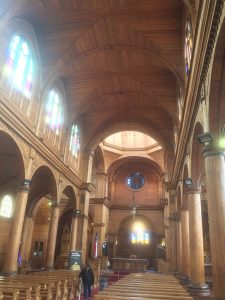In Patagonia Day 27
The Eden—Puerto Montt—Castro
Woke to the sound of trucks rolling out from deep in the ship’s hold. Some time early in the morning the Eden made port at Puerto Montt, so all the passengers packed up seabags and headed down for one last breakfast. I got coffee and went to the stern deck to watch, along with all the other guys (no stereotypes there), the trucks drive off the boat and up the pier. It was an oddly bittersweet moment as we had all become friends, even if that friendship had only consisted of smiling and making gestures of concern, happiness, or help. It’s likely many of us will cross paths in the next weeks as most people are following similar itineraries. Buses arrived to take us all downtown through the rain. Puerto Montt is a shipping and fishing town, no tourists to put up a good face for. It is subject to severe weather and has a beaten, shabby appearance. By the water, steep streets and narrow alleys lead up the hill. Perhaps I still have Moby-Dick on my mind, but many of the buildings are severely weathered and out of square, looking for all the world like those Ishmael describes as he fumbles his way around the New Bedford waterfront before beaching at the Spouter Inn.
My plan was to take a bus back down the road to Pargua and crossing by ferry over to Chiloé Island, a place markedly different from the terrain I’ve been in the past month. On the ferry I had a conversation with Jakob, a man from Amsterdam who had been on the Eden and who used to work for UNESCO. He was planning a week touring the island’s heritage sites, which are primarily very old wooden churches, many in isolated places. I hope we reconnect as he has much wisdom. Bruce Chatwin describes Chiloé as black earth and black weather, and seems right on both counts. The El Niño rain continues to follow me, though there were finally some patches of blue so perhaps a break is on the way. The soil is black as Chiloé is a somewhat flat, very large island with a more moderate inland climate (it is warmer up here). The soil is deep, as are the forests including some rainforest. While the coastal dwellers earn their living from the sea, much of the interior is agriculture, including large dairy farms. Just outside Ancud is the large dairy complex Chilolac—more factory than barn. On arriving in Castro, I made immediately for the city square in hopes of finding a restaurant for lunch and WiFi to secure a hostel. After a bit of wandering that was done. Castro isn’t geared for tourists, so the square is not crowded with places to eat, but instead seems dominated by government buildings as does much of the downtown.
The main feature of the square is the Chiloe Cathedral which at a glance looks much like the primary churches in a number of towns I have visited, but the exterior is sheet metal painted ochre (in the words of Bruce Chatwin). Seems an unlikely and unpromising material, but on entry I found a soaring church with an interior covered completely with beautiful natural wood, including massive columns made of what amounts to barrel staves. It is a remarkable and unexpected space. Apart from the old wooden Anglican Church in Wellington, I don’t recall a more reverent wooden space. This seems a town no so much down on its luck— stalls full of fresh produce, even outside the Unimarc supermarket—but just a hard place. The sidewalks are crowded with venders selling everything imaginable including bricks of dried seaweed, strings of smoked mussels, and blocks of local cheese. It sits in the bend of a bay full of fishing boats, a waterman’s town. My Spanish is not good enough to detect subtleties, but there seems a slightly different dialect here. Some unfamiliar words along with a fair amount of German. This is a town for people who work hard, which maybe helps account for a sheetmetal Cathedral.
T. Hugh Crawford


